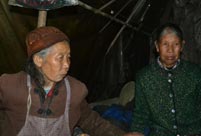

FUZHOU, March 29 -- Hundreds of villagers in an east China county have written a letter to Dutch Prime Minister Mark Rutte, hoping for the return of a 1,000-year-old mummified buddha believed to be stolen from their village in 1995.
The statue, which contains a mummified monk, was on a "Mummy World" exhibition at the Hungarian Natural History Museum that opened in October last year and was originally scheduled to be on display until May 17, but was pulled from the exhibition last week following allegations that it was stolen from a Fujian village.
The letter, jointly written by the local residents of Datian County in Fujian Province and overseas Chinese associations, has been handed to European Chinese societies and is expected to be delivered to the Netherlands via the Chinese embassy there.
"We believe that the Buddha is the one that we have been searching for in the past 20 years, and we are looking forward to its return," read the letter, in both Chinese and English.
Fujian's Cultural Relics Bureau said last week that judging from research and media reports, experts have confirmed that the statue was a relic stolen from Yangchun Village in 1995.
"[The Buddha] is our God and we have faith in him for hundreds of years. He has become an important part of our life, and we hope that it will be returned soon," read the letter.
The Dutch private collector who is in possession of the statue was quoted by Dutch daily NRC on Thursday that he is willing to give it back to the Chinese village if it is proved to be stolen from there.
According to Yangchun archives, the Buddha, named Zhanggong Zushi, was a local man who became a monk in his 20s and won fame for helping people treat disease and spread Buddhist belief. When he died at the age of 37, his body was mummified and local people made a statue with the mummy inside at around the time in China's Song Dynasty (960-1279). The statue has been worshipped in the village temple ever since.
In the temple, local people still preserve the statue's hat and clothes and other affiliated relics.
 J-11 fighters in air exercise
J-11 fighters in air exercise Beauties dancing on the rings
Beauties dancing on the rings Attendants-to-be join Mr. & Miss Campus Contest
Attendants-to-be join Mr. & Miss Campus Contest Beijing's toughest anti-smoking law takes effect
Beijing's toughest anti-smoking law takes effect Family lives in cave for about 50 years in SW China
Family lives in cave for about 50 years in SW China PLA soldiers operating vehicle-mounted guns in drill
PLA soldiers operating vehicle-mounted guns in drill Blind carpenter in E China's Jiangxi
Blind carpenter in E China's Jiangxi China hosts overseas disaster relief exercise for the first time
China hosts overseas disaster relief exercise for the first time 20 pairs of twins who will become flight attendants in Sichuan
20 pairs of twins who will become flight attendants in Sichuan Obama is sowing discontent in S.China Sea
Obama is sowing discontent in S.China Sea Rescuers work through night to reach cruise ship survivors
Rescuers work through night to reach cruise ship survivors Driving through limbo
Driving through limbo Facing down MERS
Facing down MERSDay|Week